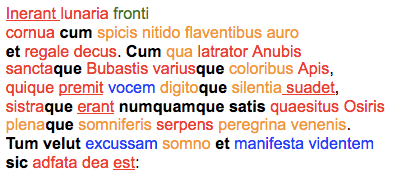The Mechanics of Translation
- Beatrice

- Oct 11, 2021
- 2 min read
Updated: Oct 12, 2021
Translating Latin is a difficult task. Unlike most other languages, even after 7+ years of experience, you can’t just pick up Latin and start reading it. Because of that, I thought I could do a blog post about how, exactly, I’m translating Latin texts into English.
My examples will be from Iphis and Ianthe, which is one of Ovid’s Metamorphoses, as that’s what I’m currently working on.
First, I find the text I’m going to be working on through the online database of the Perseus Digital Library from Tufts University. This is a fantastic (and free!) database of bunches of different ancient texts.
Then, I copy-and-paste the section of text I’m working on into a google document where I colour code it. This color coding system was invented by Mrs. Diane M., my previous Latin teacher, and it is ingrained in my brain until the end of time.
Here’s how it works: nominative, accusative, vocative, genitive, dative, ablative, prepositions/conjunctions/adverbs, infinitives, and verbs.
Here’s an excerpt from Iphis and Ianthe, lines 688-696, fully colored:

Once all the text has been colored, one of my two Latin mentors goes in and looks it over, catching any grammar mistakes I may have made. Instead of simply fixing it, they leave a comment on the document. For example, they may say “auris, is, f: can't be dative”. By giving me the principle parts, I know what declension it is in, and from there I can figure out what case it is.
Next, I copy & paste my colored text into another document, called my ‘chunking and translating’ document. Here, I break the text up into small 3-4 word ‘chunks’ so make it much more manageable to translate.

Then, I go in and translate! By breaking down the steps into grammar, syntax, and then meaning, I have a much firmer grasp on the meaning of the text.

But we’re not done yet! Once that is all done, one of my mentors goes over my translations and catches any slip-ups I have made- for example, attributing an adjective to the incorrect noun. This is also when we discuss the wider connotations of word choices, and how I can best reflect those in my translation.
Certain literary techniques that would not be immediately apparent are able to really pop due to the coloring or chunking. For example, chiasmus - a kind of ABBA grammatical structure - looks like this: “illa gravem maturo pondere ventrem” (line 685). In this excerpt, Ovid uses chiasmus to emphasize how heavily pregant a woman is. I tried to replicate this technique in my translation, saying “that weighty, from the mature weight, stomach”.
Using this set of steps, I can get through 100-200 words of poetry a week while staying sensitive to the meaning and literary techniques used in the original text.
Cool, huh?


Comments